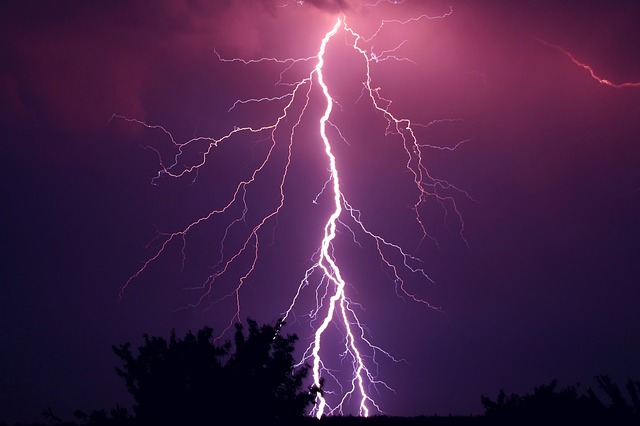
Strong storms can be a concern for any employer, but businesses that have employees who frequently work outdoors also need to consider the substantial risks of lightning. According to the National Oceanic and Atmospheric Administration, there are approximately 25 million cloud-to-ground lightning strikes in the United States every year.
Although about 90 percent of people struck by lightning survive, these discharges can cause serious and permanent disabilities. And, even if your employees aren’t hurt by lightning, they may be at risk from any fires, explosions or other hazards that result from a strike.
If employees at your business work outside, you need to take steps to reduce lightning hazards, create an emergency action plan and train your workforce.
Recognizing Increased Lightning Risks
Lightning is usually unpredictable and can occur both during heavy storms and in the complete absence of any rain. However, employees in certain roles or locations are at greater risk. Tasks that frequently expose employees to lightning include:
- Roofing
- Logging
- Construction, especially around scaffolding
- Steel structure and tower construction
- Utility field repair
- Lifeguarding
- Field labor
Some locations are also more likely to attract lightning strikes, including open fields, towers and tall trees.
Reducing Outdoor Lightning Hazards
The best way to protect your employees from lightning strikes is to have a plan in place before they’re exposed to dangerous conditions. All of your managers, supervisors and outdoor workers should collaborate on your plan to ensure it accounts for your business’s unique operations. You should also consider how your plan should be adapted for multiple workplaces if any employees work at different worksites.
Consider these tips when you’re drafting your plan:
- Train all employees on lightning safety, including early warning systems for severe weather and the best locations to take shelter when working outdoors.
- Post information on lightning safety around all of your outdoor work areas. These postings should indicate the location of safe shelters, when to stop and resume work after hearing thunder, and any other guidance that applies to your business or worksites.
- Make sure employees check weather reports before working outside. Employees should also check the weather at each worksite they’ll be visiting each day, as weather patterns can vary widely—even over short distances.
- Require employees and supervisors to monitor weather reports regularly once they’re at an outdoor worksite.
- Have employees stop work and seek shelter immediately if they hear any thunder.
- If a safe indoor structure isn’t available, have employees use a hard-topped metal vehicle as shelter.
- Set a mandatory length of time for stopping and restarting work after a lightning strike. Most lightning-related injuries and deaths occur because victims don’t seek shelter quickly enough or go back outside assuming the lightning storm is no longer a risk. The length of time before work can continue may vary based on your business and operations, but it should be at least 30 minutes after hearing the last sound of thunder.
Emergency Action Plans
Although reducing your lightning risks before a storm will help safeguard your employees, no plan can account for everything. Your business should also have an emergency action plan that gives employees specific guidance to help protect them from lightning strikes.
Your emergency action plan for lightning should encourage employees to do the following:
- Use any available early warning systems to detect lightning.
- Inform supervisors or co-workers if any thunder is heard.
- Avoid seeking shelter in small structures that won’t offer protection from lightning, such as sheds, pavilions and tents.
- Move away from any tall objects. Employees should never be the tallest object in an area if there’s a chance of lightning.
- Avoid open areas, such as fields.
- Find an area of dense, small trees that’s surrounded by larger trees or structures. However, employees should watch out for fires caused by lightning strikes or flooding from thunderstorms.
- Avoid wiring, plumbing, fencing and all other metal objects that could conduct electricity.
For more resources to help keep your outdoor workers safe, call 831-661-5697 today.
Read more

Coinsurance is one of the most complicated and misunderstood terms in insurance. This concept is commonly included in a number of different policies, including property, health and directors and officers. However, coinsurance works differently for each type of coverage, and businesses that don’t understand how it applies to property insurance may find their claims lowered unexpectedly.
Coinsurance is a common aspect of many commercial property policies. These clauses are essentially penalties that carriers use as an incentive for policyholders to purchase coverage close to the full value of their properties. And, if businesses don’t get an accurate estimate of their property’s value or purchase enough coverage, they may not have enough funds to pay for damage after any type claim.
Why Penalize Policyholders?
You can think of coinsurance as a type of smaller insurance coverage that’s included in your policy, but carriers are the ones that are protected.
During the underwriting process, insurance carriers use a property’s value to determine your policy’s details, such as premiums, limits and the deductible. As a result, inaccurate property values can change how much funding carriers have after a loss, putting them at financial risk. Essentially, the penalties from coinsurance transfer some of this risk back onto policyholders.
Insurance carriers also want to discourage businesses from buying smaller amounts of coverage. Property insurance is generally intended to cover extreme losses, including those that cost up to the full value of a property. However, most losses are relatively minor when compared to the total destruction of a building. For example, a small fire at your business may require high clean up and repair costs, but not nearly as much as the complete collapse of the entire structure.
It may be tempting to save on premiums by only purchasing coverage for these smaller claims, but this puts your business at significant risk. In the event of a total loss, your policy wouldn’t provide you with the funds you need to rebuild your business. Additionally, the gap between your policy’s limits and your property’s value affects the amount you get for every claim you make.
Calculating Penalties
Coinsurance clauses are included in many property insurance policies that offer reimbursement based on a replacement cost (the funds needed to reconstruct or repair a building with similar materials) or actual cash value (the replacement cost, minus any depreciation). These clauses specify a minimum amount of coverage—usually 80 percent of a property’s value. If you submit a claim and an inspection finds that the amount of coverage doesn’t meet the minimum limit, insurers will reduce the claims paid.
It’s important to note that insurance carriers base your property’s value on the appraisal that takes place after a claim and not any figures you provide during the underwriting process. Any estimates of your property’s value may be inaccurate or change over time, and insurance carriers need to use a figure that’s based on the time of a loss and your unique policy.
A coinsurance penalty will reduce the final payout for all property claims based on the gap between the amount of coverage purchased and the minimum limit that’s stated in the policy. Here are some examples that show how coinsurance can affect your property insurance claims:
Example 1: No Coinsurance Penalty
After conducting an appraisal, a business purchases a commercial property policy that provides $900,000 in coverage. The policy also includes a coinsurance clause that requires coverage for at least 80 percent of the property’s value. After a fire causes $200,000 in damage, an inspection by the insurer finds that the property’s value is actually $1 million. However, because the policy’s limit ($900,000) is over the 80 percent minimum of the property value (in this case, $800,000), the insurer pays the full $200,000 for the claim.
Example 2: Coinsurance Lowers the Payout
The business mentioned in the previous example purchases a property policy with the same coinsurance clause. However, this time they don’t conduct an appraisal and only obtain $600,000 in coverage. Because the policy doesn’t meet the required $800,000, the insurer will lower all payouts by the percentage between the amount of coverage and the coinsurance clause. In this example, the 25 percent gap between the $600,000 of available coverage and $800,000 required by the policy would lower the $200,000 fire damage claim to $150,000.
Removing Coinsurance Clauses
Because coinsurance can only hurt policyholders, many businesses try to remove them when negotiating with carriers. There are two common ways to do this:
- Agreed value—During the underwriting process, you and an insurer can negotiate on a set value for your property. This figure is then used during the claims process instead of a new value that’s determined after a loss. However, the agreed value only applies to the policy’s term, and you need to update this figure when renewing a policy.
- Value reporting—You can report figures such a property’s inventories, sales figures and operating costs to your insurer on a regular basis. These reports will give the insurer information on the property’s value, and are especially useful for businesses that operate seasonally.
Getting Claims Paid in Full
Coinsurance penalties can greatly limit your ability to respond to a loss, especially if an inspection finds that your property’s value is higher than you thought. Call 831-661-5697 today to ensure that your property insurance will protect you from any loss.
Read more


